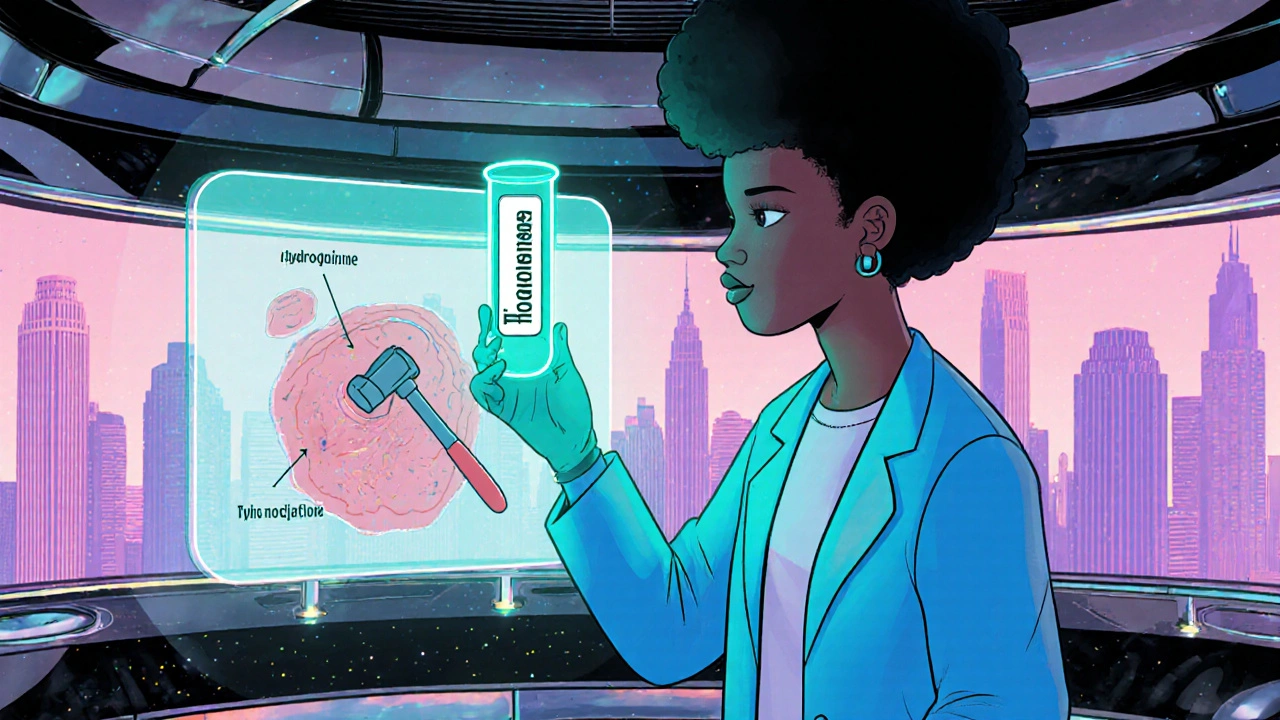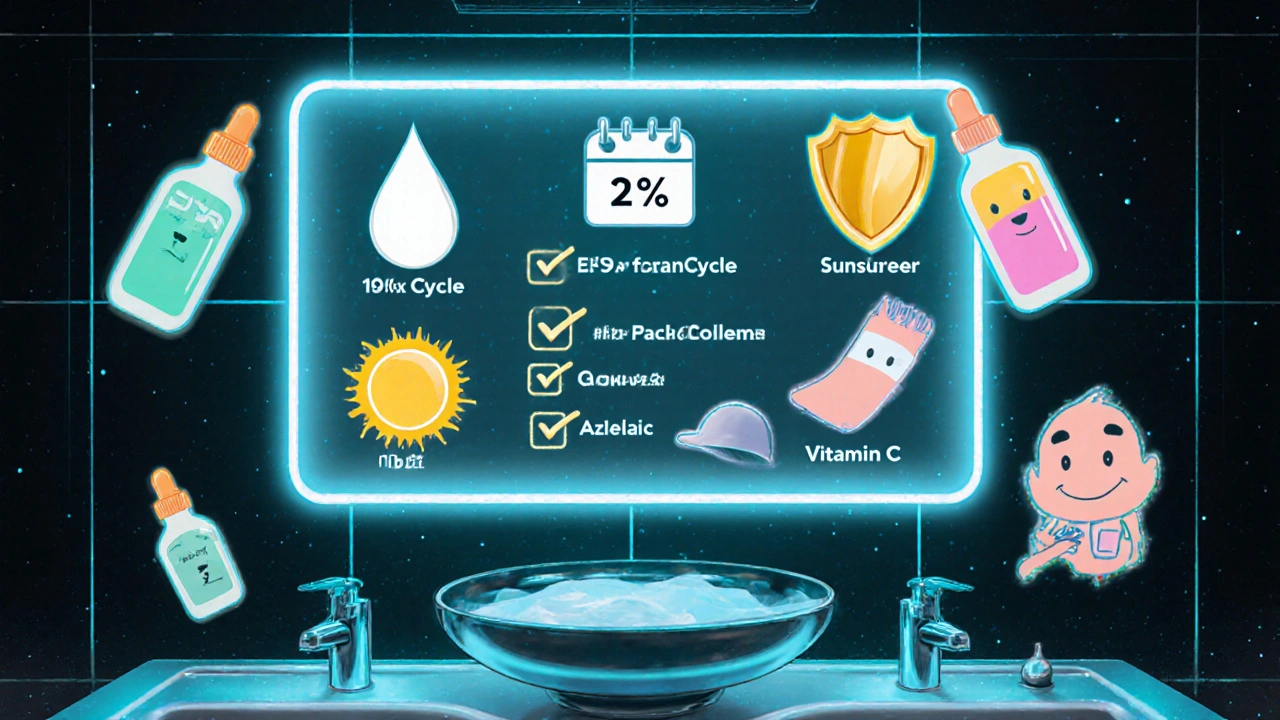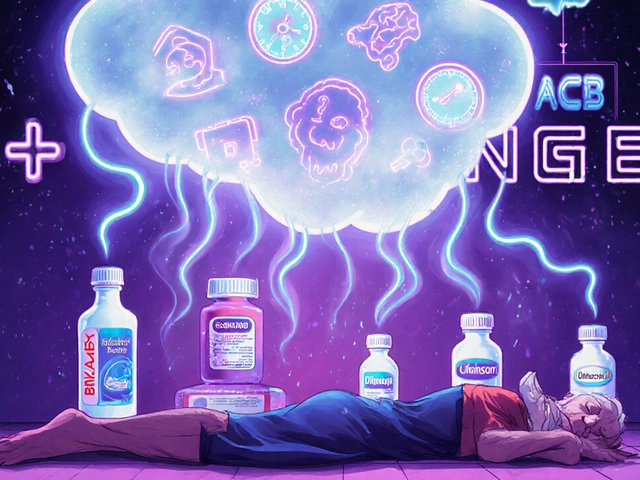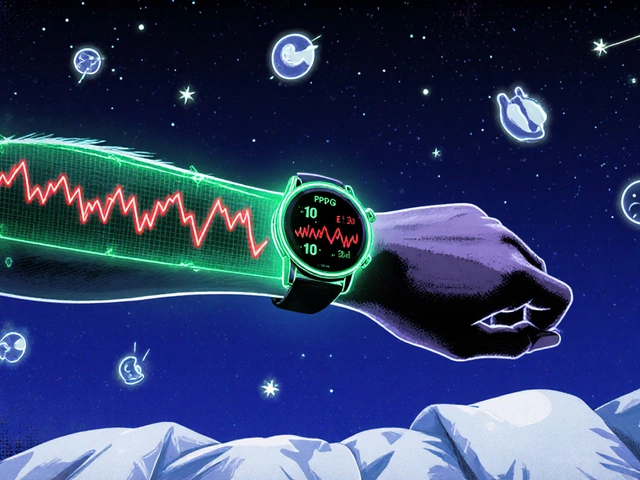
Hydroquinone Safety Calculator
How Safe is Your Hydroquinone Use?
Enter your usage parameters to see if your regimen is within safe limits.
Quick Takeaways
- Hydroquinone works by blocking tyrosinase, the enzyme that makes melanin.
- Short‑term use (up to 4 weeks) is generally well tolerated, but long‑term data are mixed.
- Regulators in the US allow up to 2 % OTC, the EU bans it in cosmetics, and several Asian markets restrict it.
- Safer alternatives such as kojic acid, azelaic acid, and vitamin C are gaining popularity.
- Always patch‑test and consult a dermatologist before starting a regimen.
When people talk about skin‑lightening agents, Hydroquinone is a synthetic phenolic compound that inhibits melanin production by blocking the enzyme tyrosinase. It’s been a mainstay in prescription‑strength brightening creams for decades.
But the question on everyone’s mind is simple: hydroquinone safety for months or even years? Let’s break down the science, the regulations, and what the real‑world experience tells us.
How Hydroquinone Lightens Skin
Melanin lives in specialized cells called melanocytes. When they become overactive - due to sun exposure, hormonal shifts, or inflammation - they dump excess pigment, creating dark patches known as melasma or post‑inflammatory hyperpigmentation.
Hydroquinone penetrates the epidermis and binds to the copper at the active site of tyrosinase, essentially turning the enzyme off. With melanin synthesis stalled, existing pigment fades over 2‑8 weeks, and new dark spots are less likely to form.
Short‑Term Safety: What the Numbers Show
Clinical trials involving 2 % hydroquinone creams report mild irritation in 10‑15 % of participants. The most common complaints are redness, mild burning, or a dry, flaky feel. These effects are usually reversible within a few days of stopping the product.
A 2022 meta‑analysis of 34 randomized studies (total N = 4,800) found no statistically significant increase in serious adverse events compared with placebo when used for up to 12 weeks. The authors concluded that short‑term use is safe for most skin types, provided the user follows proper application guidelines.

Long‑Term Concerns: What’s the Evidence?
Long‑term data are where the debate thickens. A handful of observational studies from the 1990s link continuous hydroquinone exposure (often > 6 months) to ochronosis - a paradoxical darkening of the skin that appears as slate‑gray patches.
More recent reports from dermatology clinics in Australia and the US describe rare cases of exogenous ochronosis after 2‑3 years of daily 4 % applications. The condition is reversible only with aggressive laser therapy, which can be costly and time‑consuming.
There is also a theoretical cancer risk because hydroquinone can generate reactive oxygen species (ROS) under UV light. However, long‑term carcinogenicity studies in animals have yielded mixed results, and no definitive human link has been established.
Regulatory Landscape Around the World
U.S. Food and Drug Administration (FDA) classifies hydroquinone as a “drug” when concentration exceeds 2 %. Over‑the‑counter (OTC) products are limited to 2 %, while prescription strengths can go up to 4 % with a dermatologist’s supervision.
In contrast, the European Commission banned hydroquinone in cosmetics outright in 2001, citing insufficient safety data for chronic exposure. The ban applies to both OTC and prescription products sold for cosmetic purposes.
Asian markets such as Japan and South Korea allow up to 2 % in regulated cosmetic lines, but require label warnings about possible irritation and the need for a “drug‑free” period after 3 months of use.
The Cosmetic Ingredient Review (CIR), an independent U.S. panel, concluded in 2020 that concentrations below 2 % are “safe as used in cosmetics,” but they recommend a maximum usage duration of 3 months followed by a break.

Alternatives Worth Considering
If you’re uncomfortable with long‑term hydroquinone, several alternatives offer comparable brightening effects with a gentler safety profile. Below is a quick side‑by‑side look.
| Ingredient | Typical Concentration | Mode of Action | Common Side Effects | Regulatory Status (US/EU) |
|---|---|---|---|---|
| Hydroquinone | 2 % OTC / 4 % Rx | Tyrosinase inhibition | Redness, dry skin, rare ochronosis | OTC 2 % (US) / Banned (EU) |
| Kojic Acid | 1‑4 % | Inhibits melanin synthesis via copper chelation | Mild irritation, possible sensitization | Allowed (US/EU) |
| Azelaic Acid | 10‑20 % | Blocks tyrosinase & DNA synthesis in melanocytes | Burning, itching (usually mild) | Allowed (US/EU) |
| Vitamin C (Ascorbic Acid) | 5‑20 % | Antioxidant; reduces melanin oxidation | Rare irritation, pH‑related stability issues | Allowed (US/EU) |
All four ingredients can improve uneven tone, but hydroquinone still delivers the fastest and most dramatic results, especially for stubborn melasma. The trade‑off is the stricter usage limits and the need for professional supervision.
Practical Tips If You Choose Hydroquinone
- Start low. Begin with a 2 % OTC formulation and apply only to the affected areas once daily.
- Limit duration. Stick to a 12‑week course, then pause for at least a month before restarting.
- Use sunscreen. A broad‑spectrum SPF 30+ is non‑negotiable; UV exposure can react with hydroquinone and increase irritation.
- Patch‑test first. Apply a pea‑size amount to the inner forearm for 48 hours. If redness or itching occurs, look for a milder alternative.
- Combine wisely. Pairing with a gentle moisturizer and a vitamin C serum can boost brightening while calming the skin barrier.
- Consult a dermatologist. They can monitor for early signs of ochronosis or other complications and adjust the regimen.
Remember, skin type matters. People with darker Fitzpatrick skin tones may experience more post‑inflammatory hyperpigmentation if irritation occurs, so extra caution is advised.
Frequently Asked Questions
Can I use hydroquinone on my face and body?
Yes, but keep the concentration low (2 % or less) for larger surface areas. The risk of irritation rises with the amount of skin treated, so a dermatologist‑supervised plan is best.
Is hydroquinone safe during pregnancy?
Most experts advise avoiding it while pregnant or breastfeeding because systemic absorption, though minimal, hasn’t been studied thoroughly.
How long does it take to see results?
Visible lightening typically appears after 2‑4 weeks, with peak results around 8‑12 weeks if you stick to the schedule.
What is exogenous ochronosis?
It’s a rare, paradoxical darkening that can happen after prolonged, high‑dose hydroquinone use. The spots look slate‑gray and are stubborn to fade without professional laser treatment.
Are there any drug interactions?
Hydroquinone can increase skin sensitivity to other topical acids (like glycolic or salicylic acid). If you’re using a retinoid, apply it at night and give the hydroquinone a few hours to absorb first.
Bottom line: hydroquinone can be a powerful ally for stubborn hyperpigmentation, but the safest route is short‑term, monitored use, followed by regular breaks. If you have any doubt, explore the milder alternatives or seek professional guidance.
Jameson The Owl
Hydroquinone has been marketed as the gold standard for treating hyperpigmentation and the industry’s secret agenda is to keep consumers dependent on a compound with questionable safety that is overseen by agencies that answer to corporate interests. The mechanism of tyrosinase inhibition is well documented and the literature shows that the enzyme is effectively silenced by copper binding which results in melanin synthesis cessation. Short term clinical trials demonstrate that irritation rates hover around ten to fifteen percent and these numbers are often downplayed in promotional material. Long term exposure, however, is linked to exogenous ochronosis a condition where the skin paradoxically darkens and the molecular pathways involve oxidative stress and melanin buildup. Regulatory bodies in the United States permit up to two percent over the counter while the European Union imposes a complete ban citing insufficient data on chronic use. This discrepancy reveals a geopolitical divide where regulators in allied nations protect their own pharmaceutical markets at the expense of consumer health. The research community has produced meta analyses that fail to capture rare adverse events because the study populations are too small and the follow up periods too short. Photo‑induced reactive oxygen species generated by hydroquinone under UV light provide a plausible carcinogenic pathway that is ignored in safety assessments. Dermatologists who prescribe higher concentrations are often compensated by manufacturers creating a conflict of interest that undermines impartial medical advice. Patients are encouraged to use sunscreen but compliance is low and the protective effect is further diminished by the very compound they are applying. Alternative agents such as kojic acid azelaic acid and vitamin C offer comparable brightening results with a far superior safety margin according to comparative studies. The cost of laser therapy for ochronosis is prohibitive and many sufferers are left with permanent discoloration after years of use. In practice the recommended treatment cycle of twelve weeks followed by a break is rarely enforced, leading to continuous application and heightened risk. The American Cosmetic Ingredient Review panel’s safe‑use recommendation of a three month limit is a guideline rather than a binding rule. Consumers should critically evaluate the marketing narrative and consider that the true motive behind hydroquinone’s persistence is profit, not patient welfare. Therefore the prudent approach is to avoid long term use and seek safer alternatives whenever possible.
Sarah Unrath
i think hydroquinone is just a big scam and it makes my skin act weird.
James Dean
Observing the data one sees a pattern of short term efficacy and long term uncertainty. The balance between benefit and risk is a philosophical question of how much discomfort is acceptable for aesthetic gain. Users often neglect the break periods recommended by panels. Sunscreen remains a non negotiable factor in any regimen. Ultimately the choice reflects individual tolerance levels.
Monika Bozkurt
From a regulatory standpoint the dichotomy between the United States and the European Union underscores the necessity of a risk‑benefit assessment framework grounded in toxicological endpoints and epidemiological surveillance. Hydroquinone’s mechanism of action as a reversible tyrosinase inhibitor is well characterized, yet its pharmacokinetic profile reveals dermal accumulation that may potentiate oxidative DNA damage over protracted exposure periods. Accordingly, the European Commission’s prohibition aligns with precautionary principles articulated in the REACH legislation, whereas the FDA’s classification as a drug above 2 % concentration reflects a divergent risk tolerance predicated on controlled prescription use. Clinicians should therefore integrate pharmacovigilance data with patient‑reported outcomes to formulate evidence‑based treatment algorithms that incorporate structured treatment cycles and mandatory photoprotection. The integration of alternative melanogenesis inhibitors such as azelaic acid, which exhibits a dual anti‑inflammatory and tyrosinase inhibitory activity, may provide a synergistic avenue to ameliorate hyperpigmentation while mitigating adverse event incidence.
Catherine Viola
The underlying motive behind the regulatory disparity is not merely scientific but also geopolitical; influential pharmaceutical conglomerates exert lobbying pressure that shapes policy outcomes to favor market dominance of legacy compounds like hydroquinone. Historical documents from the early 2000s reveal that the European ban coincided with a coordinated campaign by competing ingredient manufacturers seeking to expand market share for kojic and azelaic acids. This strategic maneuvering suggests that safety narratives are, at times, subordinate to commercial interests, thereby necessitating critical scrutiny of the evidentiary basis underpinning regulatory decisions. Consequently, consumers should demand transparency in risk assessment methodologies and consider the broader economic incentives that may bias safety determinations.
Ben Bathgate
Honestly hydroquinone is a shady shortcut that gives you quick results but leaves a ticking time bomb on your skin, and most people just ignore the warning labels because they’re impatient for perfection.
Christian Georg
Hey folks 😊 if you decide to use hydroquinone, start with a patch test on a small area for 48 hours, keep the concentration at 2 % or lower, and never skip sunscreen with at least SPF 30 because UV exposure can react with the cream and increase irritation. Take a break after 12 weeks, give your skin a month off, and consider rotating in a gentler brightening agent like vitamin C or azelaic acid to maintain results without overloading your melanocytes. If you notice any persistent redness or a grayish tint, stop immediately and book an appointment with a dermatologist – early intervention prevents permanent ochronosis.
Christopher Burczyk
It is essential to recognize that the consensus in peer‑reviewed dermatological literature indicates hydroquinone’s efficacy is unparalleled for melasma, yet the same corpus repeatedly emphasizes the necessity of adhering to a maximum treatment duration of three months followed by a rest period to mitigate the risk of exogenous ochronosis and cumulative dermal toxicity. Moreover, the pharmacodynamic profile demonstrates a dose‑response relationship that plateaus beyond 2 % concentration, rendering higher concentrations unjustified from a risk‑benefit perspective. Therefore, prescribing practices should be calibrated to reflect these evidence‑based parameters, and patients must be educated on proper application techniques, concomitant photoprotection, and the importance of routine dermatologic monitoring.
Caroline Keller
Using a chemical that can scar your skin is just downright selfish and irresponsible.





Write a comment